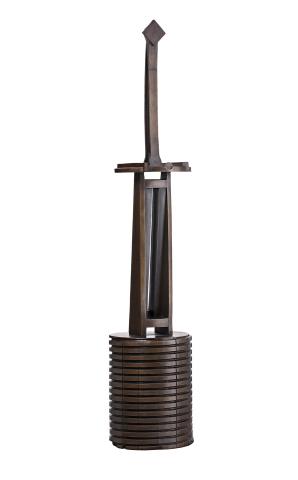OPUS 664 (b), 1987
ROBERT KLIPPEL
bronze
246.0 cm
signed with initials, dated, numbered and inscribed at base: RK 664 ’87 5/6
stamped at base with Meridian Melbourne Foundry mark
Private collection, Melbourne
Edwards, D., Robert Klippel: Catalogue Raisonné of Sculptures, (CD-ROM) Art Gallery of New South Wales, Sydney, 2002, No. 664 (illus.)
Opus 664 (a), wood assemblage, formerly in Laverty collection, Sydney
Another example of this work is included in a group of Robert Klippel sculptures on display, Brisbane Law Courts
An exact example of Klippel’s Opus 664 (b), 1987 stands in the Tank Street frontage of the Commonwealth Law Courts in Brisbane. Another example was selected for exhibition by the famous Galerie Gmurzynska in a garden setting at the Baur au Lac in Zürich in 2013 – the first showing of Klippel’s work in Europe for sixty-three years. His first solo exhibition was held in Paris in 1950 and organised by André Breton, the celebrated leader of the Surrealist movement.
Klippel’s Opus 664 was cast in bronze in an edition of six (with two artist’s proofs) by Peter Morley at his Meridian Foundry in Melbourne’s Richmond – the present work bears the foundry mark and is signed, dated and numbered as the fifth in the edition. The sculpture was created in 1987 – a notable period in Klippel’s eventful artistic life. He moved into a new studio in Sydney, held two major successful exhibitions and his work was purchased by The University of Melbourne. He was also the subject of a large retrospective exhibition at the Heide Museum of Modern Art. The following year he was awarded an Order of Australia (AO), the nation’s highest recognition of outstanding achievement.
Klippel’s Opus 664 is closely related in its compositional elements to two contemporaneous works in two significant private collections – that of Dr Joseph Brown, the prominent art dealer (No. 661 now in the collection of LaTrobe University) and Dr Colin Laverty (No. 664, wood version, recently sold by Deutscher and Hackett, 5 April 2017, lot 63), the pathologist whose research into the papilloma virus led to a vaccine for cervical cancer. The sculpture is also conceptually related to his well-known Beacon (Opus 706) of 1988 situated in the garden at Sydney’s Circular Quay.
Sometime in early 1987, Klippel embarked upon a series of works based upon the formal attributes of marine buoys and beacons. He became fascinated by the verticality of their structures and their formal and spatial transitions from thick massed bases to slender elegant apexes. For Klippel, they seemed like marine totems; ones that waved warnings, ones that demarked zones and others that pointed out directions. For a sculptor whose early days were spent on active Wartime duty in the Royal Australian Navy, their sculptural potential must have seemed almost irresistible, even after a period of forty-two years.
Perhaps it was natural that Klippel’s attention should turn that way. After all, his first major bronze sculpture of 1982, the Group of Eight commission for the National Gallery of Australia, stressed the totem-like sentinel qualities of columnar structures. These seemed to guard a place on land – bouys and beacons, on the other hand, guard a place on water.
Klippel’s vertical bronze sculpture Opus 664 shows a finely articulated progression of non-mechanical forms. Like many in this series the upright sculpture seems to point (it is topped by a lantern-like diamond shape) and its massed base almost insists on its volumetric place. The sculpture has an empathic presence and seems to define and, more importantly, confirm the space around it.
KEN WACH
